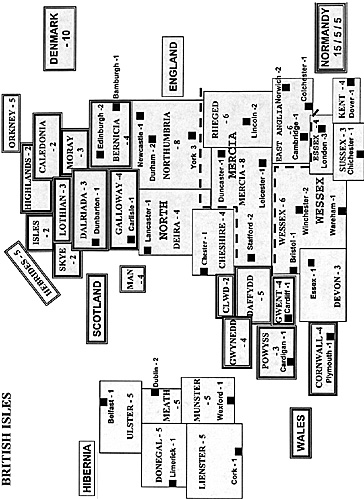 Background
Background
This campaign revolves around the time period of the Norman Conquest of Britain and provides a context for tabletop miniature battles. The campaign has 6 players, 3 major and 3 minor, each with their own forces and goals. The rules are rudimentary but provide a quick framework for creating battles and their aftermath. I use it for solitaire gaming but it can easily be used for several players and an umpire. I have drawn heavily from the Avalon Hill game on Britain, Terry Gore's medieval booklets, and the classic work of Tony Bath and Donald Featherstone. As a solo player, the "winner" is immaterial but fun to determine after playing the campaign to a logical conclusion. It can be as open-ended as anyone wants. I have played it twice and am working on a third time through, using SAGA's new medieval rules (which force some detail changes on the points system).
Players and Forces
The six players represent the major groupings of the era, each with their own specific goals. They can work together or at cross-purposes and the "winner" is the player who best accomplishes these goals within the historical context. The selection of a "winner" can be as subjective as you want and is not the real point in this game.
| Player | Rank | Goals |
|---|---|---|
| Norman | Count | Conquer everything possible, mainly Saxon areas |
| Saxon | Earl | Hold onto as much as possible (11 provinces) |
| Vikings | Jarl | Control coastal towns and seize English throne (3 provinces and 5 Irish towns) |
| Scots | Thane | Unite north (including as much of England as possible) Highlands – 4 provinces, Lowlands - 5 provinces |
| Welsh | Prince | Remain independent (keep 6 provinces) |
| Irish | Ard Ridh | Control all of Eire and gain other areas (5 provinces) |
The Normans and Vikings must be aggressive in order to "win", whereas the Saxons and Welsh are definitely on the defensive. They face challenges from everyone and must try to come to an agreement with one or more other players to have a chance of doing so. The Scots and Irish have the task of creating viable kingdoms for themselves in these turbulent times and can pick off likely areas at judicious times.
Each Province provides resources to the owner, and to invaders, measured in silver marks. These marks are used to raise and maintain military forces and special assets. Resources are available in three seasons (spring, summer, and fall), the winter provides none. However, military forces and some assets must still be "paid" for in all seasons. The map indicates the general layout of these provinces and their worth in marks. Cities provide additional resources independent of the province. Resources (silver marks) are present with the ruler or in a designated town or castle.
| Asset | Building Time | Cost/ maintain/ income | Use |
|---|---|---|---|
| Castle (Norman only) | 1 season | 2 / 1 / -- | Used to pacify/control area and prevent plundering |
| Warden (Norman only) | ---- | -- / 1 / -- | Manages 2-3 provinces, can mobilize military forces for ruler. Up to 3 available: North, Welsh Marches, and Ireland. |
| Manor | 1 year | 2 / -- / 1 | Increases the resources of a province (up to double original) |
| Ship | 1 season | 2 / -- / 1 | Sea movement of military forces and resource increase (i.e. trade) |
| Embassy | ---- | 1 / -- / -- | Make deals, subvert forces/towns, spy |
Armies can plunder a province, collecting half of the available resources, unless a castle is present and then only 1 silver mark. The owner of the province still collects the other half. Towns can be seized and plundered for twice their resource value, providing nothing for the next 8 seasons as they recover.
The map attached indicates provinces, towns, and resource levels. One silver mark equates to 100 army points (this may have to be halved for SAGA's points system). Sieges can be rolled on the dice or simply succeed automatically if there is no army present. The players have various percentages of each province they can mobilize for external or mobile warfare:
Norman: All of baseline, but only 1/4 from conquered provinces.
Saxon: Only 1/4 from each owned province. Note: Saxons have 3 "armies": Wessex, Mercia, and Northumberland.
Welsh/Irish/Scots: 1/2 from each province, 1/4 from conquered provinces
Vikings: All of their baseline if desired.
Details
Castles represent a significant investment and will generally be placed only in critical provinces. They can protect up to 1000 army points. A castle cannot be stormed but can be blockaded or taken by treachery (see below).
Wardens are important for the Normans since they can mobilize local forces within 2-3 provinces for use in a single mobile army (it will not serve outside the warden's area however). They are useful but potentially dangerous if they revolt (see below).
Manors are valuable assets that can greatly increase the value of provinces but are also vulnerable. They are added into the resource total of a province but are lost when plundered and must be rebuilt once the area is recovered.
Ships are also valuable from an economic viewpoint but they produce no revenue the season they are used to transport military forces. Each ship can transport 500 army points from any coastal area to another. When engaged in trade, they are based at a port and are vulnerable to seizure if their homeport is taken; if an enemy ship attacks them, or to random events. Note that Viking armies always have sufficient ships to move (these must be left behind/protected and are used for no other purpose).
An embassy can be used in several ways. An embassy is paid each time it is used. One must be dispatched to another ruler to form alliances, make deals, and arrange truces/peace. An embassy can be used to subvert towns, castles, or wardens (a 6 on a D6 is successful, with a +1 modifier for each silver mark spent on the task). An embassy sent to spy can reveal the plans and locations of a player's forces (success as above).
Sequence of Events
There are four seasons each year (the game begins in summer 1066) during which all actions can take place. Military units have 6 movement points, expending one point per area or province, taking an additional turn if they wish to plunder a province. Ships can move anywhere along the coasts at no cost, but military units lose one movement point to load/unload (units CANNOT remain at sea).
- Establish ownership of provinces/towns and collect resources
Expend resources (pay maintenance, buy new items)
Random events (optional)
Diplomatic events (embassies, subversion, spies)
Move units
Fight battles
Assess losses, changes in ownership
Final Comments
The rules I have outlined above are enough to play a quick campaign with about 20 tabletop battles in a 5-year game. I have an ongoing one that is already in the 11th year (1077) and revolves around the Norman consolidation and expansion into Wales and Ireland. As I said earlier, I am changing over to SAGA's medieval rules and will have to make some adjustments to resources etc. However, this will be a relatively minor change overall. I keep a campaign journal and write up other events outside the main story line. This can be as open-ended as anyone wants. I also use the story line as part of an RPG game I run with a few friends (AD&D rules).
I hope this is of interest and/or use to others. I occasionally get my wife or kids to provide input to the action (they often have some interesting ideas on the motives and actions of some of the players). This is not the only "boardgame" I have used for campaigns but it is one of the simplest. I have used AH's "Kingmaker" for late medieval games, S&T's "A Mighty Fortress" for Renaissance games, and others. They provide a ready-made basis, and acetating or redrawing the maps provides excellent "quick and dirty" campaigns.

Back to Table of Contents -- Lone Warrior #131
Back to Lone Warrior List of Issues
Back to MagWeb Magazine List
© Copyright 2000 by Solo Wargamers Association.
This article appears in MagWeb (Magazine Web) on the Internet World Wide Web.
Other military history articles and gaming articles are available at http://www.magweb.com
